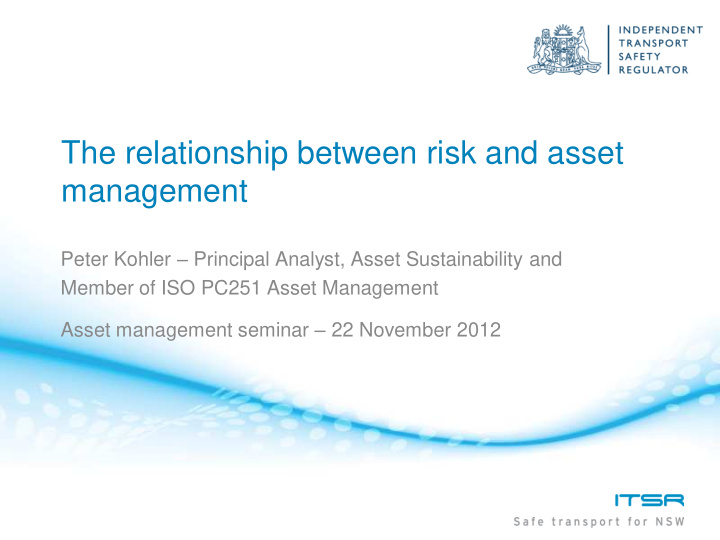



The relationship between risk and asset management Peter Kohler – Principal Analyst, Asset Sustainability and Member of ISO PC251 Asset Management Asset management seminar – 22 November 2012
Agenda This presentation aims to raise awareness of: • What is „asset management‟ • What is „risk management‟ • Some of the key risk-based processes used in the development of asset management plans.
What are assets?
Where does asset management fit? What do companies do? Concept Stakeholders Services/Outputs Business Planning that leads to with certain Risk Profiles Investment Options where the best option leads to Acquire Operate, Maintain, Dispose Plan Improve Asset Management Planning Services/Outputs
The asset lifecycle The scope of asset management includes every stage of the asset lifecycle • The asset lifecycle integrates organisational functions including Planning and Finance, Project delivery, Budgeting, Procurement, Maintenance & Operations and Disposal • „Systems engineering‟ is a tool that enables a complex multi -disciplinary project or activity to reduce the risk that the „services‟ will not be delivered (that is, be confident that they will be)
Asset lifecycle management – key risks Operate & Dispose Specify Acquire Concept Improve Non Maintain Asset Solution Change Business Financial De-commissioning Commissioning Approval Plan Approval Select services (and performance) that are not needed Select solutions that cannot meet service needs Poorly specify needed assets Assets do not meet the specification Assets do not deliver the services Difficult to improve or manage change to assets Get unexpected surprise at disposal of assets
How is risk apparent? What is engineering? The controlled transformation and use of energy. Functional = + performance Energy Asset Where functional performance is: 1. Acceptable performance 2. Acceptable risk (safety, environment, financial etc) 3. Required reliability & availability & maintainability
How is risk apparent? Asset Management System With a Failure Plans (assets & people Characteristic in use) Curve that are with imperfections in mitigated design, by … manufacture & installation lead to … Probability Parts that fail each with that releases … a certain … Consequences (Safety, Production Energy Environment) a number of … that is now uncontrolled … scenario into a … that determines …
FMEA – a risk-based analysis process Functional Business Block Diagram Requirement Reliability Block Diagram Asset Solutions Functional System Equipment Performance Functions Functions Identify Mitigation Failure Operator Modes Actions Consequence Preventive Actions H Failure Maintainer Effects Actions Corrective Actions Redesign Failure Actions Probability L Risk
Why is risk such an important tool? A short history: • Pre 1928 – Newtonian physics and Certainty • Post 1928 – Quantum mechanics and Uncertainty/Probability • Post 1946 – The explosion of Uncertainty/Probability and Risk The identification and management of risk is the fundamental basis that supports asset management. “Risk is the only tool the modern world has, that can make the future come true” Peter M Kohler
Asset management Coordinated activities of an organisation to realise value from assets ISO 55000 Asset Management
Risk and asset management Conclusion • Asset management (AM) is applied risk management, associated with the concept, design, operation and support of physical assets • Risk management (within AM) applies to the assets of all operators (there are no other tools!) • Application of AM reflects the level of risk and the business context (there is no one-size-fits-all approach) • Good AM practice: – has been identified – is documented – is demonstrably practical – makes business sense.
Risk and asset management Conclusion For more information, see the supporting paper: Sharing practice: A discussion on the relationship between risk and asset management Any questions?
Recommend
More recommend